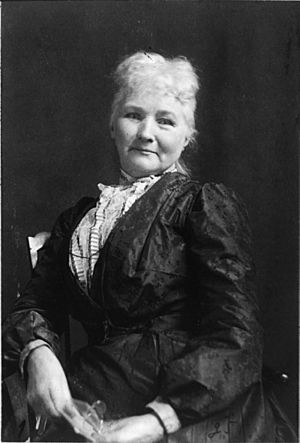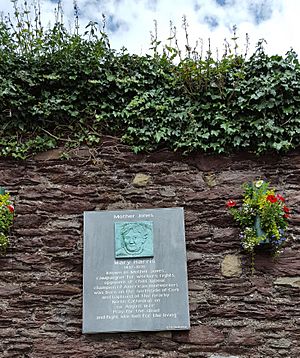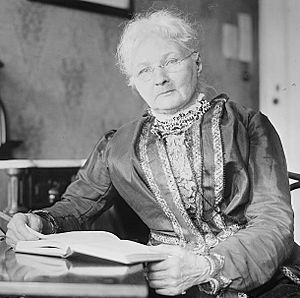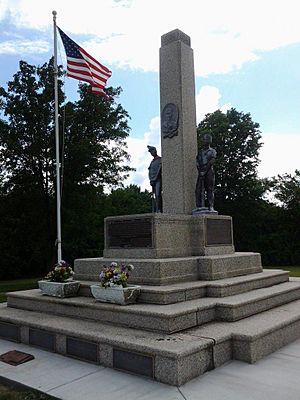Mother Jones facts for kids
Quick facts for kids
Mother Jones
|
|
|---|---|

Jones in 1902
|
|
| Born |
Mary G. Harris
|
| Baptized | August 1, 1837 |
| Died | November 30, 1930 (aged 93) Silver Spring, Maryland, U.S.
|
| Occupation |
|
| Political party | Social Democratic (1898–1901) Socialist (from 1901) |
Mary G. Harris Jones (baptized 1837 – November 30, 1930) was an amazing Irish-born American activist. She became known as Mother Jones starting in 1897. She was a former schoolteacher and dressmaker who became a very important union organizer. She helped workers fight for better conditions and pay. She also worked to stop child labor and even helped start the Industrial Workers of the World (IWW) union.
In 1867, a sad event changed her life: her husband and four young children died from yellow fever. A few years later, in 1871, her dress shop was destroyed in the Great Chicago Fire. After these tough times, she became an organizer for groups like the Knights of Labor and the United Mine Workers union. In 1902, people called her "the most dangerous woman in America." This was because she was so good at organizing mine workers and their families against powerful mine owners. In 1903, she led a special march of children from Philadelphia to the home of President Theodore Roosevelt. This march was to protest unfair child labor laws in mines and silk factories.
Contents
Early Life in Ireland
Mary G. Harris was born in Cork, Ireland. Her parents, Richard and Ellen Harris, were Catholic farmers who rented their land. We don't know her exact birth date, but she was baptized on August 1, 1837.
Mary and her family faced hard times during the Irish Potato Famine. This famine caused many Irish families to suffer. When Mary was about 10 years old, her family, like many others, moved to North America to find a better life.
Becoming an Activist
Mary was a teenager when her family moved to Canada. In Canada and later in the United States, her family faced unfair treatment. This was because they were immigrants, Catholic, and Irish. Mary went to school in Toronto at the Toronto Normal School. This school was free, and students even got a small payment each week.
Mary didn't finish school there, but she learned enough to become a teacher. In 1859, at age 23, she started teaching at a convent in Monroe, Michigan. She earned eight dollars a month. She found the school a "depressing place" and soon left teaching.
She then moved to Chicago and later to Memphis. In Memphis, in 1861, she married George E. Jones. George was a member of a union for iron molders. Because George earned enough money, Mary became a homemaker.
Life-Changing Events
In 1867, a terrible yellow fever sickness spread in Memphis. Mary lost her husband and all four of her young children, who were all under five years old. This tragedy changed her life forever.
Afterward, she moved back to Chicago and started a dressmaking business again. She made clothes for wealthy people in the 1870s and 1880s. But in 1871, the Great Chicago Fire destroyed her home, shop, and everything she owned. Like many others, Jones helped rebuild the city.
These difficult experiences led her to join the Knights of Labor, a workers' organization. She started helping to organize strikes. At first, many strikes failed. But the Knights of Labor grew very large, with over a million members.
After the Haymarket affair in 1886, the Knights of Labor began to decline. People became afraid of unions and social change. After the Knights of Labor ended, Mary Jones focused on the United Mine Workers (UMW). She often led miners in protests and encouraged them to keep striking. She believed that working men should earn enough money so their wives could stay home and care for their children. Around this time, strikes became more organized and started to win better pay for workers.
A Powerful Speaker
Mary Jones became known as a very strong and inspiring speaker. She often told personal stories to make her points. She had a pleasant Irish accent that carried well. When she got excited, her voice would get deeper.
A district attorney in West Virginia, Reese Blizzard, called her "the most dangerous woman in America" in 1902. This was during her trial for ignoring a ban on striking miners' meetings. He said, "She comes into a state where peace and prosperity reign... crooks her finger [and] twenty thousand contented men lay down their tools and walk out."
Mary Jones didn't support women's right to vote, which was unusual for female activists then. She said, "you don't need the vote to raise hell!" She believed it was more important to free the working class. When some women's rights activists criticized her, she explained, "I'm not an anti to anything which brings freedom to my class."
By the time she was 60, she started calling herself "Mother Jones." She would say she was older than she was and wore old-fashioned black dresses. She called the male workers she helped "her boys." The name "Mother Jones" first appeared in print in 1897.
"March of the Mill Children"
In 1901, workers in Pennsylvania's silk factories went on strike. Many of them were young women who wanted adult wages. A census in 1900 showed that one out of six American children under 16 years old had jobs.
John Mitchell, the head of the UMWA, asked Mother Jones to help. She went to north-east Pennsylvania to unite the striking workers. She encouraged the workers' wives to form groups. These groups would bang on pans and shout "join the union!" She felt wives were important in supporting the striking men. She believed that young girls working in the mills were being treated unfairly. She said rich people were denying these children school so their own children could go to college.
To show how bad conditions were, she visited silk mills in New Jersey. She reported that conditions there were much better. She said, "the child labor law is better enforced for one thing and there are more men at work than seen in the mills here." Mill owners argued that if they paid adult wages, they would have to close. Even Mother Jones agreed to a deal that sent the young girls back to the mills. But she continued to fight against child labor for the rest of her life.
In 1903, Mother Jones organized a famous "March of the Mill Children." These were children who worked in mills and mines. They marched from Kensington, Philadelphia, to President Theodore Roosevelt's summer home in Oyster Bay, New York. They carried signs that said, "We want to go to school and not the mines!" Each night, they held rallies in a new town with music, plays, and speeches. Thousands of people came to watch.
Mother Jones pointed out that many children at the union office had missing fingers or other injuries. She tried to get newspapers to write about the terrible conditions for child workers. But the mill owners owned parts of most newspapers. When reporters told her they couldn't publish the truth, she said, "Well, I've got stock in these little children and I'll arrange a little publicity."
President Roosevelt's secretary refused to let them meet the president. He suggested Mother Jones write a letter. She wrote a letter asking for a meeting, but she never got an answer. Even though the president didn't meet them, the march made many people aware of the child labor problem. The book Kids on Strike! (2003) tells the story of Mother Jones's Children's Crusade in detail.
Later Years and Death
Mother Jones continued to organize for the UMW into the 1920s. She kept speaking about union issues almost until she died. She wrote a book about her life called The Autobiography of Mother Jones (1925).
In her later years, Jones lived with her friends Walter and Lillie May Burgess on their farm in what is now Adelphi, Maryland. On May 1, 1930, she celebrated her 100th birthday there (though she was actually 93). She was even filmed for a newsreel.
Mary Harris Jones died on November 30, 1930, at the Burgess farm. She had a funeral service in Washington, D.C.
She is buried in the Union Miners Cemetery in Mount Olive, Illinois. She rests alongside miners who died in the 1898 Battle of Virden. She called these miners, who were killed during a strike, "her boys." In 1932, about 15,000 Illinois mine workers gathered at her grave. They decided to buy a proper headstone for her. By 1936, they had saved over $16,000. They bought a huge granite monument with statues of two miners and a carving of Mother Jones.
On October 11, 1936, which is also Miners' Day, about 50,000 people came to see the new memorial. Since then, October 11 is celebrated in Mount Olive as "Mother Jones's Day." The farm where she died was later called the "Mother Jones Rest Home." Today, a Maryland Historical Trust marker is at the site, and a nearby elementary school is named after her.
Mother Jones's Legacy
Mother Jones's words still inspire union supporters today: "Pray for the dead and fight like hell for the living." She was known as "the miners' angel." When someone in the United States Senate called her the "grandmother of all agitators," she replied, "I hope to live long enough to be the great-grandmother of all agitators."
- During a coal strike in 1989–90, the wives and daughters of striking miners called themselves the "Daughters of Mother Jones." They were inspired by her work and played a key role in the strike.
- The magazine Mother Jones was started in the 1970s and became very popular.
- Mary Harris "Mother" Jones Elementary School in Adelphi, Maryland is named in her honor.
- In 1984, she was added to the National Women's Hall of Fame.
- In 2012, a plaque was put up in her hometown of Cork City, Ireland, to mark her birthplace. The Cork Mother Jones Festival is held there every year.
- A historic marker in Pratt in West Virginia remembers her imprisonment there during a strike.
- In 2019, Mother Jones was honored by being added to the National Mining Hall of Fame.
Mother Jones in Music and Arts
- Some people believe the song "She'll Be Coming 'Round the Mountain" is about Mother Jones visiting coal-mining camps.
- Gene Autry recorded a song called "The Death Of Mother Jones" in 1925.
- The folk singer Utah Phillips performed a piece called "The most dangerous woman," referring to Mother Jones.
- The play Can't Scare Me...the Story of Mother Jones is performed by actress Kaiulani Lee.
- Mother Jones in Heaven is a musical about her life.
- Mother Jones and the Children's Crusade is another musical based on her work in Pennsylvania.
See also
 In Spanish: Mary Harris para niños
In Spanish: Mary Harris para niños




